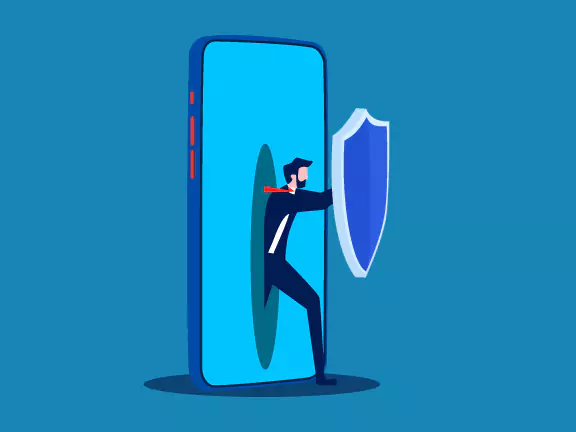Your phone holds a treasure trove of personal information—from passwords and bank accounts to private messages and photos. Unfortunately, that makes it an attractive target for hackers looking to steal data or disrupt your digital life. Knowing how to prevent phone hacks is crucial to keeping your information safe and your phone secure.
Understanding 4 Common Types of Phone Hacks
Hackers use a variety of tactics to infiltrate phones and gain access to sensitive data. By understanding these methods, you’ll be better equipped to defend against them.
1. Phishing Scams
Phishing scams use fake websites, emails, or messages to trick you into sharing personal information like login credentials or credit card details. These scams often appear legitimate, mimicking trusted organizations to lower your guard.
How It Happens: You might receive an email or text that looks like it’s from your bank, asking you to “confirm your account” by clicking a link. Once clicked, you’re redirected to a fake website designed to collect your information.
Why It’s Dangerous: Sharing this data gives hackers direct access to your accounts, allowing them to steal money or personal information.
2. Malware Attacks
Malware is malicious software designed to infiltrate your phone, often disguised as legitimate apps or downloads. Once installed, it can steal your data, track your activity, or lock your phone until a ransom is paid.
How It Happens: Malware often comes from clicking suspicious links, downloading apps from untrustworthy sources, or opening malicious email attachments.
Why It’s Dangerous: Malware can run in the background, giving hackers continuous access to your phone and its contents.
3. Public Wi-Fi Exploits
Using unsecured public Wi-Fi networks can expose your phone to hackers who intercept your data. This type of attack is especially common in coffee shops, airports, and hotels.
How It Happens: Hackers create fake Wi-Fi networks or exploit vulnerabilities in unsecured connections to intercept data like passwords and payment information.
Why It’s Dangerous: Once connected, a hacker can monitor your online activity and even access sensitive accounts.
4. SIM Swapping
SIM swapping occurs when a hacker convinces your mobile carrier to transfer your phone number to a new SIM card under their control. This gives them access to accounts linked to your number.
How It Happens: Hackers often impersonate you, providing enough personal details to trick your carrier into making the switch.
Why It’s Dangerous: With control of your number, hackers can bypass two-factor authentication and gain access to your online accounts.
5 Ways to Prevent Phone Hacks
Taking proactive steps can significantly reduce your risk of being hacked. Here’s how you can secure your mobile phone.
1. Set Up Strong Security Measures
Protecting your phone starts with making it difficult for anyone to access without your permission.
Use a Strong Password: Avoid simple passwords like “123456” or “password.” Instead, use a combination of letters, numbers, and symbols.
Enable Biometric Authentication: Features like fingerprint or facial recognition add an extra layer of security.
2. Update Software Regularly
Updates often include fixes for security vulnerabilities that hackers could exploit. Keeping your phone’s operating system and apps up to date is essential.
Enable Auto-Updates: Set your phone to automatically download software updates to ensure you never miss critical patches.
Stay Current: Regular updates make your device more resistant to emerging threats.
3. Download Apps from Trusted Sources
Apps from unverified sources are a common way for malware to infect your phone. Stick to official app stores like the Google Play Store or Apple’s App Store.
Check Reviews: Before downloading, read reviews to ensure the app is legitimate.
Limit Permissions: Be cautious about granting apps unnecessary access to your contacts, location, or photos.
4. Use Two-Factor Authentication (2FA)
Two-factor authentication provides an additional layer of security for your online accounts. It requires a second form of verification, such as a code sent to your phone, in addition to your password.
How to Set It Up: Use 2FA apps like Google Authenticator or enable this feature directly in your account settings.
Why It’s Effective: Even if someone steals your password, they won’t be able to access your account without the second verification.
5. Be Careful with Public Wi-Fi
Public Wi-Fi networks are convenient but often unsecured, leaving your phone vulnerable.
Use a VPN: A Virtual Private Network encrypts your connection, making it harder for hackers to intercept your data.
Avoid Sensitive Activities: Don’t access banking apps or enter passwords while connected to public Wi-Fi.

Warning Signs of a Hacked Phone
Knowing the signs of a hacked phone can help you take action before more damage occurs.
1. Strange Activity
Unfamiliar apps appearing on your phone or unauthorized texts sent from your number could indicate a hack. These activities often happen without your knowledge.
2. Rapid Battery Drain
If your phone’s battery suddenly starts draining quickly, it could be due to malware running in the background. Malware uses your phone’s resources, leading to faster battery depletion.
3. Unusual Pop-Ups
Frequent pop-ups, especially ones with ads or warnings, may indicate the presence of adware or spyware on your device.
4. Unauthorized Account Activity
Check your accounts for suspicious logins or transactions. Hackers often use stolen credentials to access email, banking, or social media accounts.
What to Do If Your Phone Is Hacked
If you suspect your phone has been compromised, take immediate action to minimize the damage.
1. Disconnect Immediately
Turn off your phone to prevent further unauthorized access. This can stop malware or hackers from continuing to exploit your device.
2. Change Passwords
Using a secure device, update the passwords for all accounts connected to your phone. Focus on financial and email accounts first.
3. Run Security Software
Use a trusted mobile device security app to scan your phone for malware and malicious apps and remove any threats.
4. Perform a Factory Reset
If the issue persists, perform a factory reset to wipe your phone and restore it to default settings. Make sure to back up essential data before resetting.
Additional Tips for Long-Term Security
Securing your phone requires ongoing vigilance. Here are more ways to protect your mobile device.
Monitor App Permissions: Regularly check which apps have access to your sensitive data. Remove permissions for apps that don’t need them.
Back Up Your Data: Store important files and information in the cloud or on encrypted drives to prevent data loss.
Avoid Clicking Suspicious Links: Be cautious with links in emails, texts, or pop-ups, even if they appear to come from a trusted source.
Protect Your Phone and Stay Secure
Knowing how to prevent phone hacks can save you from losing sensitive information, money, and peace of mind. By implementing these strategies, you can stay ahead of hackers and keep your phone secure.
FREE Cell Phone Service with EASY Wireless
Reliable phone service is essential for maintaining your security and accessing the tools you need to protect yourself. EASY Wireless offers FREE cell phone service through the Lifeline Program, providing free talk, text, and data to keep you connected.
What EASY Wireless Offers:
Free Talk, Text, and Data: Perfect for managing accounts, receiving security alerts, and staying in touch with loved ones.
Eligibility: If you qualify for programs like SNAP or Medicaid, you likely qualify for EASY Wireless.
Apply Today
Visit one of our 40+ Oklahoma EASY Wireless stores to sign up for FREE Cell Phone Service
or…


